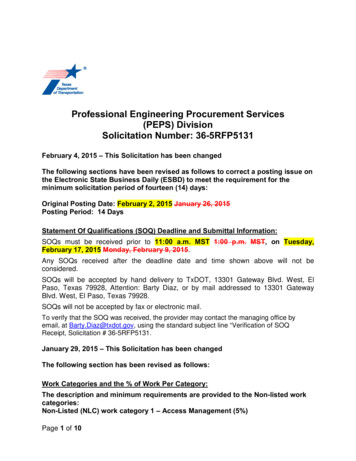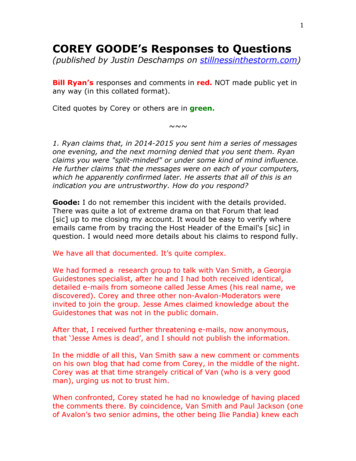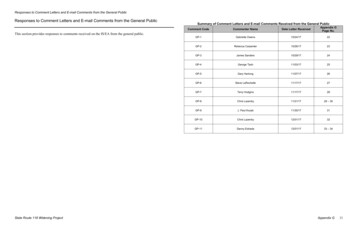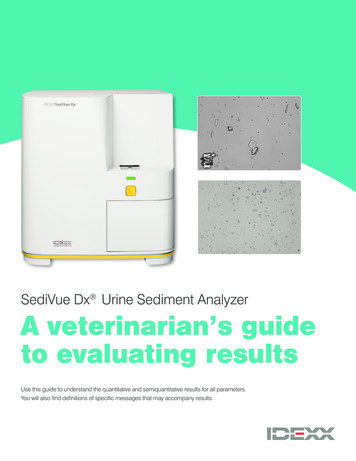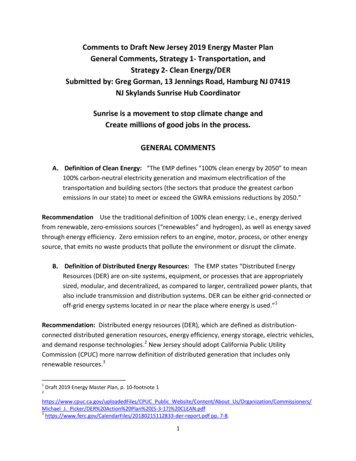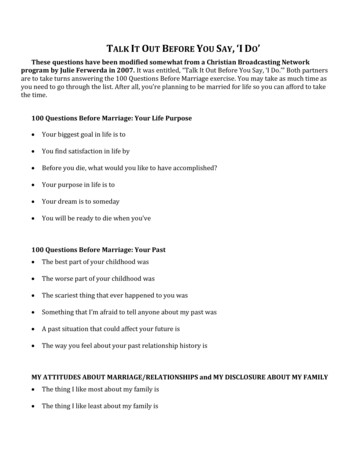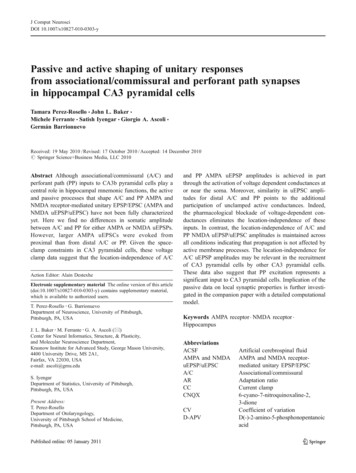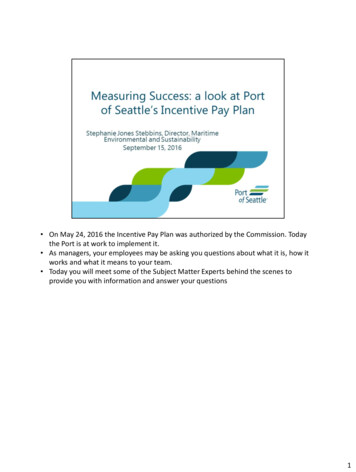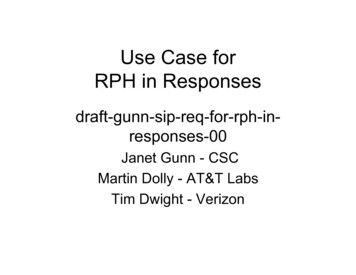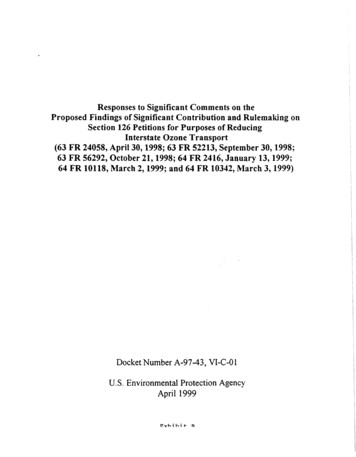
Transcription
Responses to Significant Comments on theProposed Findings of Significant Contribution and Rulemaking onSection 126 Petitions for Purposes of ReducingInterstate Ozone Transport(63 FR 24058, April 30,1998; 63 FR 52213, September 30,1998;63 FR 56292, October 21,1998; 64 FR 2416, January 13,1999;64 FR 10118, March 2,1999; and 64 FR 10342, March 3,1999)Docket Number A-97-43, VI-C-01U.S. Environmental Protection AgencyApril 1999RvhihihR
pool also provides further allowances in the trading market for the first two years of theprogram (see compliance supplement pool discussion in Section IV of final rule preamble).In addition, many States are in the process of developing a trading program under the NOxSIP call. Since, a trading program will be promulgated by EPA for this section 126rulemaking all sources subject to any final section 126 remedy will be subject to the tradingprogram.SUMMARY: Commenter objects to EPA's denial of commenter's petition with respect tolarge process heaters. Commenter points that implementation of a regional NOx budgetprogram adopted by the OTC indicates that a trading program is available for these sourceswithin the OTC Commenter questions why such a similar program is not being imposed byEPA on large process heaters.LETTERS: Connecticut Dept. of Environmental Protection (IV-D-19), Midwest OzoneGroup (V-H-58), Pennsylvania Power & Light, Inc. (V-H-l 19)RESPONSE: Table 7 4 0 of the Regulatory Impacts Analysis (RIA) for the NOx SIP call(Volume 1, September 1998) shows the annual costs and resulting average cost-effectivenessfor each regulatory alternative for process heaters. Annual monitoring and administrativecosts are not estimated for this category of sources because it is evident from Table 7-10 thateven without these additional costs there is no regulatory alternative that meets EPA'scriteria for highly cost-effective ozone season NOx emissions reductions. That is, whenemissions decreases are considered at all large process heating sources (i.e., regulatoryalternatives applying greater than 4,000/ton of control), the resulting average costeffectiveness clearly exceeds EPA's cost-effectiveness criteria of less than 2,000 per ton ofNOx reduction.Although a trading program is available for process heaters under the OTC, EPA hasdetermined that controlling process heaters across the entire region potentially covered bysection 126 is not highly cost effective. If EPA were to include monitoring costs in its costeffectiveness number and assume that a trading program would achieve a 30 percentreduction in the cost-effectiveness number, controlling process heaters would still cost morethan 2,000 per ton of NOx removed. Thus, for the final rule, EPA concludes that processheaters do not emit in amounts that significantly contribute to petitioning States'nonattainment or maintenance problems.SUMMARY: Commenters object to EPAs denial of commenter1 s petition with respect toEGUs between 15 and 25 MW Commenters advocates capping such sources at 1990 levelsconsistent with the OTC NOx MOU. The commenters argued that this action would behighly cost-effective since it would not require additional controls in a market driven NOxcontrol program. One commenter argued that inclusion of these sources will control theshifting of power production to smaller sources. One of the commenters stated that control103
of 15-25 MWe boilers is highly cost effective because they believe that the petitions clearlydemonstrate these sources do have a significant impact.LETTERS: Connecticut Dept of Environmental Protection (IV-D-19), New York Dept. ofEnvironmental Conservation (II-D-5), Pennsylvania Dept. of Environmental Protection (IID-26), Midwest Ozone Group (V-H-58), Pennsylvania Power & Light, Inc. (V-H-l 19),(Maine, IV-D-75)RESPONSE: In the NOx SEP call (see 63 FR at 57402), EPA found that the collectiveemissions from small sources were relatively small (in the context of that rulemaking) and theadministrative burden, to the permitting authority and to regulated entities, of controllingsuch sources was likely to be considerable. Even if EPA were not to apply additionalcontrols beyond capping small sources at 1990 levels, there would be administrative coststhat would be considerable in comparison to the emissions reductions gained. Thus,controlling small sources (less than 25 MWe) is not appropriate for EPA to mandate.Data is often lacking for the smaller size sources. This level allows the rulemaking tofocus on the group of emission sources that contribute the vast majority of emissions, whileat the same time avoids assuming emissions reductions from a very large number of smallersources. This approach provides more certainty and fewer administrative obstacles while stillachieving the desired environmental results.Assuming controls on the smaller EGUs would also be inconsistent with the approachEPA proposed and is taking for non-EGUs. That is, the 250 mmBtu non-EGU cutoff isapproximately equivalent to the 25 MWe cutoff level for EGUs EPA is generally treating thenon-EGU boilers/turbines in the same manner as the EGUs to develop a simple and effectivetrading program. Consistency with the EGU approach is also important because it providesequity, especially among the smaller boilers and turbines.Finally, EPA maintains that the potential for shifting power production to smallerunaffected sources is minimized because such a large portion of electric generating units aresubject to the NOx trading program. In the final action, EPA concludes that small sourcesdo not emit in amounts that significantly contribute to petitioning States' nonattainment ormaintenance problems.SECTION IV,D, Compliance Supplement PoolSUMMARY: Most commenters expressed support for a compliance supplement pool aspart of the trading program. However, others noted that the compliance supplement poolmay not be appropriate and/or legal as part of a section 126 remedy because it could result inan extended compliance period beyond the 3-year requirement provided for under section126. Another commenter stated specifically that the compliance supplement pool should notbe included along with the FIP. Other commenters noted that requiring the use ofcompliance supplement pool credits by 2004 provided no environmental benefit. Finally, two
EPA has taken a fuel neutral approach in establishing 0.15 lb/mmBtu limit whichdoes not favor one fuel type over another. A 0.05 lb/mmBtu control level for gas and oilfired units selected would effect the cost-effectiveness (possibly increasing costs) because itwould limit the number of allowances available for trading EPA believes that 0.15 lb/mmbtulimit can easily be achieved by gas and oil-fired boilers, of which over half already operate atNOx levels below a 0.15 ib/MMBtu emission limit and should therefore easily be able togenerate emission credits if trading is allowed. The EPA recognizes that for coal-firedboilers to operate at or below this limit, Selective Catalytic Reduction (SCR) will generallybe necessary. However, under a trading scenario, if one coal-fired boiler is able to emitbelow this level by installing SCR, it can provide emission credits to another boiler, thusobviating the need for that boiler to install SCR. The EPA believes that ample allowanceswould exist to sustain a market under the NOx Budget Trading Program. Results of ananalysis of this issue can be found in the RIA.Therefore, EPA believes that the 0.15 Ib/MMBtu standard is reasonable andappropriate.SUMMARY: Commenter supports considering the average cost of control and notdifferentiating between large and small sources within the affected category because with theanticipated trading program, units with high costs of control will be able to trade with thosehaving lower control costs to minimize the overall cost of control.LETTERS: NY DEC (II-D5)RESPONSE: EPA believes that trading for large combustion sources under a budget that isdeveloped based on this limit is a feasible, cost-effective means of meeting the budget. TheEPA performed an analysis to determine the cost effectiveness of NOx controls applied tolarge utility boilers and how it compared to other section NOx controls. The results indicatethat controlling emissions to an average level of 0.15 Ib/MMBtu was highly cost effective.EPA found that the collective emissions from small sources were relatively small and theadministrative burden, to the permitting authority and to regulated entities, of controllingsuch sources was likely to be considerable in comparison to the emissions reductions gained.Thus, controlling small sources (less than 25 MWe) is not appropriate for EPA to mandate.SUMMARY: A number of commenters supported a phased-in approach. Thesealternatives included the phase-in proposals submitted by ACAP and the Midwest/SoutheastGovernors Ozone Coalition, as well as other various proposals. Other commenters,however, opposed any phase-in approach because delaying or phasing in the NOx reductionswill negatively impact the environment.LETTERS: Allegheny Power (V-H-140), Indiana Department of EnvironmentalManagement (V-H-l 16), New Hampshire Department of Environmental Services (V-I-39),West Virginia Chamber of Commerce (V-H-l 73), Cinergy (II-D-23)121
times for completing SCR installation and Found that power did move betweenregions in the event of longer outage times. UARG maintains that scheduling outages may be a problem given the advent ofcompetition. According to UARG, utilities may be unwilling to coordinate theiroutage schedules in light of increased competition in the electric power industryEPA maintains that it is reasonable to assume that utilities will continue to cooperateand coordinate their outage schedules as they currently do. Even with increasedcompetition, utilities and independent power producers will likely be concerned aboutreliability and the need for coordination, particularly since customers will have anincreased ability to change electric suppliers. UARG states that there may not be enough catalyst for the amount of SCRinstallation that they believe will occur. UARG did not provide any support forthe assumption that the supply of catalyst will be insufficient. EPA's Feasibility ofInstalling yOx Control Technologies by May 2003 demonstrates that it would not be aproblem to provide the amount of catalyst that UARG maintains is needed.EPA also notes that the ECAR letter to Carol Browner points out reliability concernsraised in the ten-year assessment of ECAR-wide capacity margins that it appears could beexacerbated by the NOx SEP Call. However, the ECAR ten-year assessment actually raisedconcerns for reliability during the summer peak period, whereas the installation of SCRtechnology will occur during off-peak periods. (See Memo from ICF Kaiser to EPA datedSeptember 15, 1998.)UARG suggested that NESCAUM agrees with UARG's position on reliability.However, NESCAUM has responded that it does not agree with UARG's position. (SeeSeptember 1998 NESCAUM letter to EPA.)SECTION VI. D: Impact on Small EntitiesSUMMARY: Commenter supports the position to exclude boilers with generators of 25MW or smaller in size because it is not cost-effective. A study conducted by SFT, Inc.estimated the cost to comply with a 0.15 lb/mmBtu limit for the commenter's generatingunits. This study calculated the annual cost to install and operate SCR for boiler #8. Basedon a debt service rate of 4.5 percent and an installation date of 2002, the annual cost for thistechnology is SO.95 million dollars or 2.1 percent of the commenter's projected 1998revenues. The cost per ton removed is S4,107 which is much greater than the projected costeffectiveness of 51,468/ton for large EGUs and 1,477 for large non-EGUs.LETTERS: City of Hamilton Ohio (IV-D-74, III-D-65)RESPONSE: EPA agrees that the cost-effectiveness of controls for small units is less andthat the administrative costs for small units without monitors is greater. In the final action,165
EPA concludes that small sources do not emit in amounts that significantly contribute topetitioning State's nonattainment or maintenance problems.SUMMARY: Commenters argued that cost-effectiveness analysis inappropriately relies onregion-wide, source category-wide estimates and fails to consider the relative economies ordiseconomies inherent in controlling individual EGUs. One commenter maintained thecompliance cost impact small facilities inordinately because of lesser economies of scale inrelation to large competitors and because many have not yet had to invest in Title IVcontrols. In addition, the commenter argued that the investment in Title IV controls areworthless because the rule virtually requires the installation of post-emission controltechnology.LETTERS: City Utilities of Springfield (MO) (IV-D-93, III-D-20), City of Orville Ohio(IV-D-85)RESPONSE: EPA recognizes that there can be differences in the cost of implementingcontrols on various fossil fuel-fired EGUs. The potential cost impacts of differences in boilercharacteristics and applicable control technologies have been accounted for in the EPManalysis used by EPA in estimating cost impact of the rule on EGUs. The Agency's smallentity screening analysis documents that the rule will not impose a significant impact on mostsmall entities.EPA disagrees that the rule virtually requires the installation of post-emission controltechnology. EPA is not imposing specific controls on sources and is in fact providingflexibility so that a source may choose the most cost-effective option, including the additionof control technologies or the purchase of NOx allowances. Title IV controls (such ascombustion controls) are not worthless because they can be used in conjunction with postemission control technology and lead to a reduction in the amount of post combustioncontrol needed (e.g., less SCR catalyst is needed). They also can be used to reduce theamount of NOx allowances that need to be purchased.SUMMARY: Commenter maintains that EPA's estimate of EGUs cost to comply with therule are substantially understated. The commenter estimates its own costs to comply will fallwithin the range of 4-8% of its electricity revenues. The commenter also maintained that it isinfeasible to raise its rates to recapture these expenses because it has nearby competitors thatwill not incur these costs.LETTERS: City Utilities of Springfield (MO) (IV-D-93, III-D-20)RESPONSE: EPA agrees that the cost for the commenter to comply with the rule will fallbetween 4 and 8 percent of annual revenues. EPA estimates that the commenter's most costefficient response to the section 126 rule would be to implement a mix of technologies andmanagement strategies, including SCR technology. EPA estimates that the commenter's costis likely to be approximately 5 percent of annual electricity generation revenue. This impact
MondayMay 11, 1998r iiPart IIEnvironmentalProtection Agency40 CFR Parts 51, 76, and 96Supplemental Notice for the Finding ofSignificant Contribution and Rulemakingfor Certain States in the Ozone TransportAssessment Group Region for Purposesof Reducing Regional Transport ofOzone; Proposed Rule nExhibit C
Federal Register/Vol. 63, No. 90/Monday. May 11, 1998/Proposed Rulesequal to or greater than their actualemissions for that quarter.In terms of NOX emitters, theRECLAIM program generally requiresstationary sources that emit ten or moretons of NOx annually or which burn anysolid fuels to use OEMS to quantify theiremissions. Smaller sources haveadditional monitoring options. Sourcesthat emit four or more tons of NOX andless than ten tons may use defaultemission rates. They must demonstratethat these rates are appropriate bymonitoring process variables,performing periodic emissions testing,and conducting periodic tune-ups ofequipment. The smallest sources in theRECLAIM program (those with annualemissions of less than four tons) maychoose to use default emission rates thatrequire less extensive testing anddemonstration than those available tothe larger sources.The program's annual report for 1996concluded that RECLAIM wascontinuing to meet its emissionsreduction goals; an active tradingmarket had developed; and thecompliance rate, once it is finalized forthe 1996 compliance year, will be in the85 to 90 percent range.May 1 of each year and ending onSeptember 30 of the same year), NOXBudget unit (a unit subject to theemissions limitation under the NOxBudget Trading Program), and severalothers are added. Key definitions arediscussed in relevant Sections belowdescribing the rule.c. Applicability. The EPA proposesthat the NOX Budget Trading Rule beapplicable to a core group of sourcesthat includes all fossil fuel-fired,stationary boilers, combustion turbines,and combined cycle systems (i.e."units") that serve an electricalgenerator of capacity greater than 25MWe and to any fossil fuel-fired,stationary boilers, combustion turbines,and combined cycle systems not servinga generator that have a heat inputcapacity greater than 250 mmBtu/hr. Aunit is considered fossil fuel-fired iffossil fuels account for more than 50percent.of the unit's heat input on anannual basis. These sources representabout 80 percent of the point sourceportion of the 2007 NOx baselineemissions inventory and about 65percent of the point source portion ofthe 2007 NOx budget in the proposedozone transport rulemaking.Additionally, these sources representabout 90 percent of the emissionsC. NOx Budget Trading Programreductions required in the proposed1. General Provisionsozone transport rulemaking.Today's proposed NO* BudgetThe EPA proposes the above coreTrading Rule will be incorporated intogroup of sources based on theirthe 40 CFR as a new part 96. Thesignificant contribution of NOXsubparts of 40 CFR part 96 are described emissions, range of cost-effectivebelow. The provisions of 40 CFR part 96 emissions reduction options, ability towill become effective and apply tomonitor emissions, and ability tosources only if a State incorporates 40identify responsible parties. TheCFR part 96 by reference into the State's following discussion examines theregulation or adopts regulations that are monitoring and responsible partyin accordance with 40 CFR part 96.criteria for the NOx Budget Tradinga. Purpose. Subpart A of today'sProgram's applicability. Additionalproposed NOX Budget Trading Ruleoptions for the trading program'sapplicability are also presented forincludes Sections describing: To whomconsideration. The EPA solicitsthe NOx trading program would apply;comment on the appropriateness ofthe standard requirements forparticipants in the program (permitting, including all categories described abovein the core group of sources, whetherNOx allowances, monitoring, excessthe size cut-offs should be higher oremissions, and liability provisions);lower for these source categories, andexemptions for retired units from thethe appropriateness of including otherprogram requirements; definitions,source categories in the core group.measurements, and abbreviations; and/. Monitoring. In general, sources thatcomputation of deadlines stated withinparticipate in a cap-and-trade programthe proposal.must have the ability to accurately andb. Definitions. Measurements,consistently account for their emissions.Abbreviations, and Acronyms.Accuracy is an important designMany of the definitions,parameter because it ensures thatmeasurements, abbreviations, andemissions for all sources covered by theacronyms are the same as those used intrading program are within the cap. In40 CFR part 72 of the Acid Rainaddition, because each NOx allowanceProgram regulations, in order towill have economic value, it ismaintain consistency among programs.important to ensure that emissions (andHowever, additional terms specific tothus allowances used) are accuratelythe NOX Budget Trading Program, suchquantified. Consistency is an importantas control period (the period beginningfeature because it ensures that accuracyis maintained from source to source andyear to year. It also ensures that thesources in the trading program aretreated equitably. Finally, consistencyfacilitates administration of the programfor both the regulated community andState and Federal agencies.When considering what source typesto include in the proposed tradingprogram (e.g. large boilers, processsources, mobile sources, area sources),EPA determined that the core sourceswere capable of accurate and consistentmonitoring as outlined below. Large Electric Utility Units: Forseveral years, units serving electricitygenerators greater than 25 MWe (withsome exemptions for cogeneration andnonutility electricity generating units)have been complying with the title IVmonitoring provisions. The EPAproposes to include these sources in theNOx Budget Trading Program. Other Large Electricity GeneratingUnits: Additionally, with deregulationof electric utilities, it is not clear howownership of the electricity generatingfacilities will evolve. Therefore, EPAproposes to include all large electricitygenerating sources, regardless ofownership, in the trading program. Asthere is no relevant physical ortechnological difference betweenutilities and other power generators, thesame monitoring provisions and the-sizecut-off of greater than 25 MWe areapplicable to all units which servegenerators. Other Large Steam Producing Units:There is also no fundamental physicalor technological difference between aboiler, combustion turbine, or combinedcycle system that produces steam foreventual production of electricity or forother industrial applications. Thus, EPAbelieves that the same monitoringprovisions can be applied to a boiler,combustion turbine, or combined cyclesystem used for industrial steam.13ii. Responsible Party. Another criticalelement of a trading program is to beable to identify a responsible party foreach regulated source. The responsibleparty for a source covered by the tradingprogram would be required todemonstrate compliance with theprovisions of the NOx Budget TradingProgram. In general, the large sourcesincluded in the proposed tradingprogram have readily identifiableowners and operators that would serveas the responsible party.13Further, assuming a generator efficiency ofapproximately ",. the 25 MWe cutoff being used forelectrical power producers is roughly equal to a 250mmBiu/hr cutoff for steam producing boilers,combustion turbines, and combined cycle systems.
71220Federal Register/Vol. 63, No. 247/Thursday, December 24, 1998/Rules and RegulationsCommander, no person or vessel mayenter or remain in the regulated area.regatta or marine parade are excludedunder that authority.Regulatory EvaluationList of Subjects in 33 CFR Part 100ENVIRONMENTAL PROTECTION40 CFR Parts 51 and 96This rule is not a significantMarine Safety, Navigation (water).[FRL-6198-1]regulatory action under section 3(0 ofReporting and recordkeepingExecutive Order 12866 and does notrequirements. Waterways.Correction and Clarification to therequire an assessment of potential costsFinding of Significant Contribution andTemporaryRegulationsand benefits under section 6(a)(3) of thatRulemaking for Purposes of Reducingorder. It has been exempted from reviewIn consideration of the foregoing, Part Regional Transport of Ozoneby the Office of Management and100of Title 33, Code of FederalAGENCY: Environmental ProtectionBudget under that order. It is notAgency (EPA).significant under the regulatory policies Regulations is amended as follows:and procedures of the Department ofACTION: Final rule; correction andPART 100—[AMENDED]Transportation (DOT) (44 FR 11040;clarification.February 26, 1979). The Coast Guard1. The authority citation for Part 100SUMMARY: The EPA is correcting andexpects the economic impact of this rule continues to read as follows:clarifying certain aspects to theto be so minimal that a full RegulatoryAuthority: 33 U.S.C. 1233: 49 CFR 1.46 and requirements for 22 States and theEvaluation under paragraph lOe of the33 CFR 100.35.District of Columbia to submit Stateregulatory policies and procedures ofimplementation plan (SIP) revisions toDOT is unnecessary. Since the2. A temporary section 100.35-T05prohibit specified amounts of emissionsregulations will only be in effect for one 106 is added to read as follows:of oxides of nitrogen (NO X ) (alsohour, the impacts on routine navigationreferred to as the NO X SIP call). Most§ 100.35-T05-106 Cape Fear River,axe expected to be minimal.Wilmington, North Carolina.Small EntitiesUnder the Regulatory Flexibility Act(5 U.S.C. 601-612), the Coast Guardmust consider whether this rule willhave a significant economic impact ona substantial number of small entities."Small entities'* include independentlyowned and operated small businessesthat are not dominant in their field andthat otherwise qualify as "smallbusiness concerns" under section 3 ofthe Small Business Act (15 U.S.C. 632).Because it expects the impact of thisrule to be minimal, the Coast Guardcertifies under 5 U.S.C. 605(b) that thistemporary final rule will not have asignificant economic impact on asubstantial number of small entities.Collection of InformationThese regulations contain nocollection of information requirementsunder the Paperwork Reduction Act of1995 (44 U.S.C 3501-3520).FederalismThe Coast Guard has analyzed thisrule under the principles and criteriacontained in Executive Order 12612 andhas determined that this rule does nothave sufficient federalism implicationsto warrant the preparation of aFederalism Assessment.EnvironmentThe Coast Guard considered theenvironmental impact of this rule andconcluded that, under figure 2-1,paragraph (34)(h) of COMDTINSTM16475.1C. this rule is categoricallyexcluded from further environmentaldocumentation. Special localregulations issued in conjunction with a(a) Definitions:(1) Regulated Area. The waters of theCape Fear River from shoreline toshoreline, bounded on the north by aline drawn along latitude 34*14.4' Northand bounded on the south by a linedrawn along latitude 34*14.0' North. Allcoordinates reference Datum NAD 1983.(2) Coast Guard Patrol Commander.The Coast Guard Patrol Commander isa commissioned, warrant, or pettyofficer of the Coast Guard who has beendesignated by the Commander. CoastGuard Group Fort Macon.fb) Special Local Regulations:(1) Except for persons or vesselsauthorized by the Coast Guard PatrolCommander, no person or vessel mayenter or remain in the regulated area.(2) The operator of any vessel in thisarea shall:(i) Stop the vessel immediately whendirected to do so by any official patrol,including any commissioned, warrant,or petty officer on board a vesseldisplaying a Coast Guard ensign.(ii) Proceed as directed by any officialpatrol, including any commissioned,warrant, or petty officer on board avessel displaying a Coast Guard ensign.(c) Effective Dates. This temporaryfinal rule is effective from 11:30 p.m. onDecember 31, 1998 to 12:30 a.m. onJanuary 1.1999.Dated: December 8. 1998.Roger T. Rufe, Jr.Vice Admiral, U.S. Coast Guard Commander.Fifth Coast Guard District. FR Doc 98-34133 Filed 12-23-98: 8:45 amiBILLING CODE 4910-15-MExhibit Dimportantly. EPA is reopening theperiod for emissions inventory revisionsto 2007 baseline sub-inventoryinformation used to establish eachState's budget in the NO X SIP Call toFebruary 22. 1999. This includessource-specific emission inventory dataand vehicle miles traveled (VMT)'andnonroad mobile growth rates, VMTdistribution by vehicle class, averagespeed by roadway type, inspection andmaintenance program parameters, andother input parameters used in thecalculation of highway vehicleemissions. T h e comment period for2007 baseline sub-inventory revisionswill be reopened for two related noticesof proposed rulemaking concerningClean Air Act section 126 petitions (thesection 126 proposal) and Federalimplementation plans for the NO X SIPcall (the FIP proposal) in a future action.DATES: This rule is effective DecemberADDRESSES: Dockets containinginformation relating to this rulemaking(docket Nos. A - 9 6 - 5 6 . A - 9 7 - 4 3 , and A 98-12) are available for publicinspection at the Air and RadiationDocket and Information Center (6102).U.S. Environmental Protection Agency.401 M Street SVV. room M-1500,Washington. DC 20460. telephone (202)260-7548, between 8:00 a.m. and 4:00p.m., Monday through Friday, excludinglegal holidays. A reasonable fee may becharged for copying. E-mail is A - A N D R-DOCKET-GROUP@EPA.GOV.FOR FURTHER INFORMATION CONTACT:General questions concerning.today'saction should be addressed to Kimber S.Scavo. Office of Air Quality Planningand Standards. Air Quality Strategiesand Standards Division. MD-15,
Federal Register/Vol. 63, No. 247/Thursday, December 24, 1998/Rules and RegulationsResearch Triangle Park, NC 27711,telephone (919) 541-3354: e-mail:scavo.kimber@epa.gov. Specificquestions on emissions inventoryupdates should be directed to GregStella, Office of Air Quality Planningand Standards, Emissions Monitoringand Analysis Division, MD-14,Research Triangle Park, NC 27711,telephone (919) 541-3649: e-mail:steila.greg@epa.gov.SUPPLEMENTARY INFORMATION: By noticedated October 27. 1998, EPA published."Finding of Significant Contributionand Ruleraaking for Certain States in theOzone Transport Assessment GroupRegion for Purposes of ReducingRegional Transport of Ozone," 63 FR57356, which may be referred to as theNOX SIP call. By notice datedSeptember 30, 1998. EPA proposed,"Findings of Significant Contributionand Rulemakings on Section 126Petitions and Federal ImplementationPlans for Purposes of ReducingInterstate Ozone Transport." 63 FR52213. On October 21. 1998, EPApublished longer, more detailedversions of these proposals entitled"Findings of Significant Contributionand Rulemaking on Section 126Petitions for Purposes of ReducingInterstate Ozone Transport," 63 FR56292. and "Federal ImplementationPlans to Reduce the Regional Transportof Ozone," 63 FR 56394. The section
A 0.05 lb/mmBtu control level for gas and oil-fired units selected would effect the cost-effectiveness (possibly increasing costs) because it would limit the number of allowances available for trading EPA believes that 0.15 lb/mmbtu limit can easily be achieved by gas and oil-fired boilers, of which over half already operate at

